Okinawa Campaign
Contributor: C. Peter Chen
ww2dbasePre-invasion Operations
ww2dbaseOn 25 Mar 1945, American forces landed on the islands of Kerama Retto, 15 miles west of Okinawa, Japan. On 31 Mar, the island of Kamiyama was occupied as the American naval vessels bombarded Okinawa relentlessly.
ww2dbaseLanding at Okinawa
1 Apr-21 Jun 1945
ww2dbaseOperation Iceberg struck the island of Okinawa in the Ryukyu Islands on the date of the Easter holiday in 1945. Okinawa was a relatively large island, 60 miles long and eight miles wide; it was the largest of the Ryukyu Archipelago situated between Taiwan and Japan. Immediately to its west was the small island of Ie Shima. Before the landing operation started, Allied bombers softened Okinawa of its defenses and morale, which resulted in the destruction of over 80% of the city of Naha and the sinking of over 65 boats. Admiral Richmond Turner, veteran commander of amphibious forces, delivered landing forces, with ships of the British Pacific Fleet among his vanguard. The amphibious vehicles landed the 96th and 7th Army Divisions on the left flank, and the 1st and 6th Marine Divisions were delivered on the right. Once on land, the combined forces of Chester Nimitz's Marines and Douglas MacArthur's soldiers, the first time their men fought side-by-side, were placed under the command of Lieutenant General Simon Bolivar Buckner, Jr. The landing was not resisted, much to the surprise of the landers. There were no coastal guns, no mortars, and no machine guns; it was a scene very much unlike the previous landings elsewhere in the Pacific Ocean. Deep in the island, however, the 110,000-strong Japanese garrison led by Lieutenant General Mitsuru Ushijima, augmented by 20,000 volunteer Okinawan militiamen, awaited. The only reason they held back was because they were waiting under orders for the completion of Operation Ten'ichigo (see below).
ww2dbaseThe Americans' immediate objectives were the Yontan and Kadena airfields, and they were very quickly taken. Yontan was so quickly taken that a Japanese pilot actually made a successful landing, got out of his fighter, and ordered loudly for a full tank of gas before he realized the men around his plane were Americans; he was gunned down before he could reach for his pistol. The two airfields were declared secure by 20 Apr. In northern Okinawa, the Motobu Peninsula was entrenched by two battalions under the command of Takehiko Udo, who inflicted 1,304 casualties among the American invaders before letting his positions become overrun by Americans. Southern Okinawa proved to be much more difficult. Near the Machinato Line, 300,000 people, Japanese, American, and Okinawan civilians, concentrated in a small area. When Marine veteran and historian William Manchester arrived at the scene, he thought that it was "what Verdun and Passchendaele must have looked like", comparing the great battle scene to the grotesque trench warfare battlegrounds of WW1. The complex of Sugar Loaf Hill, Horseshoe Ridge, and Half Moon Hill was one of the most fiercely contested regions in the entire battle. With each hill covering the other two, the Japanese had connected the three hills with hidden galleries and set up interlocking fields of fire by machine gun and various types of artillery. At Half Moon Hill, veteran Eugene Sledge recalled:
ww2dbaseA small distance in the east was Shuri Hill, which provided machine gun fire to the entire complex as well. It was a death trap for the American Marines who were given the task to assault it, but the Marines took on the task dutifully. Horrendous casualties were incurred on both sides, with at times entire assaults cut down to a handful of survivors. Sugar Loaf Hill had changed hands 14 times before it was finally taken by the Americans.
ww2dbaseAt noon on 7 May, the Americans celebrated Victory in Europe Day with a "terrific, thundering artillery and naval gunfire barrage that went swishing, roaring, and rumbling toward the Japanese."
ww2dbaseMany front line fighters at Okinawa recalled a gross infestation of maggots, fueled by the dead bodies strewn around the battlegrounds. "If a [U.S.] Marine slipped and slid down the back slope of the muddy ridge," Sledge recalled, referring to a slop where many Japanese dead lay buried in shallow graves,
ww2dbaseThroughout the entire Japanese campaign at Okinawa, Ushijima knew there was little chance of winning, especially after Operation Ten'ichigo failed. His only hope was to discourage the Americans with the kind of high casualty rate he had delivered against the invaders so that they would back away from invading the Japanese home islands.
ww2dbaseFollowing the retreat from Shuri, the Japanese defenders formed a final defensive line along the ridges between Kunishi Ridge, Yuza-Dake, and Yaeju-Dake, from west to east. The Japanese dug in to caves and gun emplacements on the hard coral surface, setting up excellent gun positions on high ground, covering the northern approaches that were open with rice paddies and grasslands. On 12 Jun, the 3rd Battalion of the 7th Marine Regiment of the US 1st Marine Division attacked Kunishi Ridge before dawn, capturing a portion of the hill but quickly became isolated as the Japanese fought from beneath them; only under the cover of tanks could supplies be delivered to the mountain top and the wounded be evacuated. On 14 Jun, 1st Marine Regiment of the US 1st Marine Division and the men of the 1st Marine Battalion attacked Kunishi Ridge and Yuza-Dake, respectively. The hills were not secured for several days, with terrible losses on both sides.
ww2dbaseThe island fell on 21 Jun. Some of the Japanese troops that survived past the American declaration of Okinawa being secure fought on ferociously. During "mop-up" operations, 8,975 Japanese were killed. During the fighting, General Buckner was killed by a ricocheting artillery shell while he toured the front lines, making him the highest ranking American to die during the war. Alongside Buckner, 7,613 Americans fell, and 31,807 were wounded in action. Non-combat American casualties reached 26,221, largely attributed to the heavy concentration of Japanese artillery at Okinawa and the fanatical fighting spirit of the Okinawan defenders. On the Japanese side, 107,539 dead were counted by the Americans, though the actual deaths were almost certainly higher as at least 20,000 were sealed in caves either by American action or Japanese suicide. Only 7,455 Japanese surrendered. Approximately 42,000 Okinawan civilians were killed during the battle.
ww2dbaseOperation Ten'ichigo (Ten-Go)
6-7 Apr 1945
ww2dbaseThe Operation Ten'ichigo, also known as Operation Ten-Go, was a massive coordinated naval suicide attack led by the battleship Yamato, under the command of Vice Admiral Seiichi Ito. The fleet reached Kabuto Jima on 28 Mar 1945, then sailed for Ube. Ito strongly objected this mission, claiming three major weaknesses with the planning. First, a total absence of air cover at this phase of war when American aircraft controlled air meant the ship would be detected right away; secondly, a mission by ten ships would be overwhelmed by the sixty enemy ships before they could do any damage; finally, Ito argued the daylight timing for the battle was terrible (he preferred a night-time engagement). Nevertheless, Ito was overruled by his superiors, and he accepted his duty as the task force's commander. He radioed an inspiring message to all of his men that noted "[t]he fate of the homeland rests on this operation."
ww2dbaseThe operation's ultimate goal was to sail the ten ships into the American fleet and do as much damage with their guns as possible, especially with the massive 18-inch guns of the Yamato. If they were not able to do so, they were to beach themselves at various beaches of Okinawa and become shore batteries, and the sailors would then disembark to become infantry. Finally, if that failed, she then was to draw as much fire from American aircraft as possible so that the concurrent Operation Kikusui would confront less resistance from the air.
ww2dbaseAlthough this was meant to be a one-way cruise, contrary to popular belief the ships actually had enough fuel to make a return trip. This fact, however, was concealed from the officers and sailors, therefore the theory of the ships having only enough fuel for a single trip is commonly accepted.
ww2dbaseJapanese Navy veteran Kazuhiro Fukumoto recalled:
ww2dbaseBattleship Yamato, light cruiser Yahagi, and eight destroyers left the ports at Ube on 6 Apr 1945 at 0600 and stopped for ten hours at Tokuyama to receive fuel and unload non-essentials. As the crew gathered the night before the attack for a final feast, Fukumoto realized the mission must be a desperate one as he witnessed officers showing atypical kindness to the crewmen, helping with cleanup and joined in conversation with them. Almost immediately out of port, they were spotted by American submarines and reconnaissance planes. When day broke on 7 Apr, American commander Marc Mitscher ordered his carriers to launch nearly 300 aircraft to attack the Japanese task force. Admiral Raymond Spruance ordered six battleships to sail behind the air attack in case any Japanese ships would get through the fighter screen. The Japanese detected the American aerial force at 1130, and the battle started at about 1220. Anti-aircraft guns were the Japanese's only air defense aside from the minuscule force of five land-based fighters that turned out to help, which was swiped aside within moments. American aircraft sank Yahagi immediately, and hit Yamato with bombs and torpedoes. Yamato was seriously damaged within 15 minutes of the battle, recalled Naoyoshi Ishida who served aboard the Yamato as an officer at the time.
ww2dbaseWithin and hour, three destroyers were sunk, but the Japanese fleet sailed on. After a painful slow listing to port, the Yamato finally capsized at 1420 on 7 Apr, two hours after receiving the first hit. A moment later, she exploded twice as the shells from the primary and secondary magazines fell off their shelves and detonated. The loss of the ship took the lives of 2,488 men; only 279 survived. "I thought we wouldn't be able to win, but I didn't expect us to go down so easily", said Ishida. The price paid by the Americans for taking down the world's largest battleship was merely ten aircraft and twelve lives.
ww2dbase"Bravery? Recklessness?" Asked Ensign Mitsuru Yoshida regarding the decision to launch this mission; he was a radar officer who survived the sinking.
ww2dbaseOperation Kikusui
6 Apr-22 Jun 1945
ww2dbaseTokko ("special attack") aircraft caused much frustration and destruction for the Allies. Five American carriers were damaged (three had to return to the US for repairs); the British fared better as their carriers, the prime tokko target, were armored and not easily penetrated. The Okinawa campaign saw a concerted special attack mission, Operation Kikusui ("Floating Chrysanthemum"), calling for 860 naval and 605 army aircraft to strike the Allied forces between 6 Apr and 21 Jun. The warrior Kusunoki Masashige conducted a brave but futile defense in the Battle of Minatogawa in 1336, and in the final moment before defeat, he committed ritual suicide rather than allowing himself to become captured; he had since become a legend in Japanese history, and his emblem, a floating chrysanthemum, became the inspiration for the 1945 defense of Japan. Operation Kikusui, launched in 10 waves between Apr and Jun 1945, involved about 800 Navy and 600 Army aircraft. Special attacks caused over 30 American vessels of various sizes sunk and 368 damaged, killing over 5,000 sailors with as many wounded during the campaign for Okinawa. It was the most substantial loss the US Navy had ever seen in the Pacific War, and it demoralized the sailors. However, there was only so much suicide aircraft could do. Like previous campaigns, successful tokko missions only allowed Japan to become victims of her own success as the number of pilots and aircraft dwindled.
ww2dbaseConclusion of the Campaign
ww2dbaseThe loss of the battleship Yamato, which bore Japan's mystical name, was so shameful that Prime Minister Kuniaki Koiso resigned on the same day as the ship's sinking.
ww2dbaseFor its strategic location, the occupying American forces remained in Okinawa after the war. It remained under American control until 15 May 1972 when it was finally returned to Japan, though the American military bases there are active until this day.
ww2dbaseSources:
Rikihei Inoguchi and Tadashi Nakajima, The Divine Wind
William Manchester, Goodbye, Darkness
Yoshida Mitsuru, Requiem for Battleship Yamato
Eugene Sledge, With the Old Breed
Dan van der Vat, The Pacific Campaign
Steven Zaloga, Kamikaze
Last Major Update: Sep 2007
Okinawa Campaign Interactive Map
Photographs
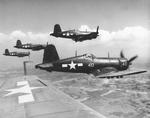 | 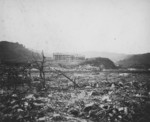 | 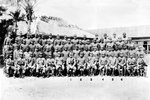 | 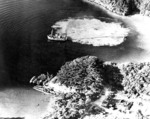 |
Maps
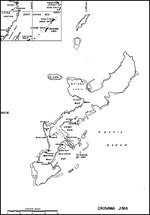 | 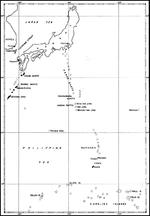 | 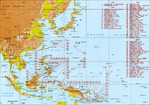 | 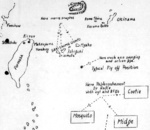 |
Videos
 |  |
Okinawa Campaign Timeline
| 23 Mar 1945 | USS Yorktown (Essex-class) began softening-up strikes against Okinawa, Ryukyu Islands and continued through 28 Mar 1945. |
| 26 Mar 1945 | A small scale special attack by aircraft was conducted by the Japanese off Okinawa, Japan, but a large scale tokko campaign was to come in the future. |
| 26 Mar 1945 | USS New Mexico shelled Japanese positions on Okinawa, Japan. |
| 26 Mar 1945 | USS Portland commenced destructive bombardment of Okinawa from the west, all in advance of the landings to take place one week later. Portland would continue this assignment for nearly a month. |
| 26 Mar 1945 | USS Kimberly was struck by a special attack D3A aircraft; 22 men were lost. |
| 26 Mar 1945 | As USS St. Louis was conducting a shore bombardment of Okinawa, one torpedo passed ahead of the ship and another behind. |
| 27 Mar 1945 | USS Ancon departed the Mariana Islands for the invasion of Okinawa with Transport Squadron 15. |
| 27 Mar 1945 | USS Anzio and USS Tabberer arrived on station off Okinawa and remained for 52 days covering the landings there. |
| 28 Mar 1945 | USS St. Louis conducted a shore bombardment of Okinawa, continuing for the next two days. |
| 30 Mar 1945 | USS Yorktown (Essex-class) pounded Okinawa, Ryukyu Islands and its surrounding islets in softening-up strikes. |
| 30 Mar 1945 | British warships including the battleship HMS King George V, under the command of Vice Admiral Sir Bernard Rawlings, and a carrier force led by HMS Illustrious, commanded by Rear Admiral Sir Philip Vian, participated in an attack on the Sakashima Islands, 180 miles south-west of Okinawa, Japan. |
| 31 Mar 1945 | USS Yorktown (Essex-class) pounded Okinawa, Ryukyu Islands and its surrounding islets in softening-up strikes. |
| 31 Mar 1945 | USS St. Louis rearmed at Kerama Retto and conducted additional bombardments of Okinawa. |
| 1 Apr 1945 | As the landings began on Okinawa, aircraft from escort carrier USS Sargent Bay resumed their close air support missions supporting the ground forces. |
| 1 Apr 1945 | USS Yorktown (Essex-class) began several days of direct support missions for the troops landing on Okinawa, Ryukyu Islands. About every three days, USS Yorktown (Essex-class) retired east for refueling, rearming, and re-provisioning. |
| 1 Apr 1945 | USS Kimberly departed Okinawa, Japan. |
| 1 Apr 1945 | Casablanca-class escort carrier USS Steamer Bay and her task group arrived in their operating area southeast of Okinawa and began support operations. |
| 1 Apr 1945 | US Tenth Army invaded Okinawa, Japan. Japanese aircraft launched a massive counter-attack, damaging USS West Virginia, USS Tennessee, and HMS Indefatigable, among others. |
| 3 Apr 1945 | USS Ancon was ordered to move further away from Okinawa, Japan due to dangers from Japanese aircraft. |
| 5 Apr 1945 | SS Hobbs Victory was struck by Japanese special attack aircraft while at anchor between Kuba and Aka Islands near Okinawa, Japan. She steamed into the East China Sea as the ships in the anchorage dispersed. She was discovered by the Japanese and was struck by another special attack aircraft, destroying her port side boiler and rendering her dead in the water. |
| 6 Apr 1945 | SS Hobbs Victory, struck by two special attack aircraft on the previous day, was destroyed in the East China Sea when the ammunition in her cargo hold exploded amidst firefighting efforts. |
| 6 Apr 1945 | Operation Kikusui No. 1 was launched off Okinawa, Japan, participated by about 230 Japanese Navy and 125 Japanese Army special attack and escorting aircraft. |
| 7 Apr 1945 | Destroyer Yukikaze rescued survivors of battleship Yamato and destroyer Isokaze; she suffered minor damage from American air attacks during the action (3 were killed, 15 were wounded). |
| 7 Apr 1945 | Kosaku Ariga, commanding officer of battleship Yamato, went down with the ship as the battleship sank. |
| 7 Apr 1945 | When Yamato was discovered was steaming south, Air Group 9 from USS Yorktown (Essex-class) claimed several torpedo hits on Yamato herself just before the battleship exploded and sank. USS Yorktown (Essex-class)?s planes also had at least three 500-pound bombs hit light cruiser Yahagi before that ship also sank. Yorktown then resumed her strikes on Okinawa. |
| 7 Apr 1945 | While enroute to attack the US fleets off Okinawa, Japan, battleship Yamato was attacked by US carrier aircraft resulting in her loss, along with several of her escorts. |
| 8 Apr 1945 | Two destroyers were damaged by Japanese special attack boats and aircraft off Okinawa, Japan. |
| 9 Apr 1945 | The Japanese Navy scored a notable success against the Americans when a large Shinyo Motor Boat packed with explosives charged out of Naha harbour, Okinawa, Japan to ram the USS Charles J. Badger putting the destroyer out of the war with both engines utterly unserviceable. A landing-craft was sunk on the same night and, from the fringes of the destroyer screen, came a report of swimmers armed with hand-grenades, although whether these were, in fact, Fukuryu ("Crawling Dragons") suicide-frogmen still remained uncertain. |
| 11 Apr 1945 | USS Ancon set sail for Saipan, Mariana Islands. |
| 11 Apr 1945 | USS Missouri, USS Enterprise, USS Essex, and 6 destroyers were damaged by Japanese special attack aircraft off Okinawa, Japan. |
| 12 Apr 1945 | Operation Kikusui No. 2 was launched off Okinawa, Japan, participated by about 125 Japanese Navy and 60 Japanese Army special attack and escorting aircraft. Destroyer USS Mannert L. Abele was sunk by a Japanese Ohka piloted bomb off Okinawa; she was the first to be struck by an Ohka bomb and was the only to be sunk by one. |
| 14 Apr 1945 | Japanese special attack aircraft damaged a battleship and two destroyers off Okinawa, Japan. |
| 15 Apr 1945 | Operation Kikusui No. 3 was launched off Okinawa, Japan, participated by about 120 Japanese Navy and 45 Japanese Army special attack and escorting aircraft. |
| 16 Apr 1945 | US Army troops landed on Ie Shima off Okinawa, Japan. Meanwhile, Japanese special attack aircraft sank a destroyer and damaged a number of other warships. |
| 19 Apr 1945 | A major attack was launched against Japanese positions on Okinawa, Japan. |
| 21 Apr 1945 | Americans declared Ie Shima, Japan secure. |
| 22 Apr 1945 | Japanese special attack aircraft sank a minesweeper and damaged a number of other ships off Okinawa, Japan. |
| 27 Apr 1945 | Northwest of Okinawa, destroyer USS Ralph Talbot was struck by a special attack aircraft and nearly struck by another. The result was five men killed, many more wounded, and moderate damage to the ship. |
| 27 Apr 1945 | Operation Kikusui No. 4 was launched off Okinawa, Japan, participated by about 65 Japanese Navy and 50 Japanese Army special attack and escorting aircraft. |
| 28 Apr 1945 | Japanese special attack aircraft damaged 5 destroyers, 2 hospital ships, and victory ship Bozeman Victory off Okinawa, Japan. None of the four G4M bombers carrying Ohka special attack aircraft hit their targets. |
| 3 May 1945 | Operation Kikusui No. 5 was launched off Okinawa, Japan, participated by about 75 Japanese Navy and 50 Japanese Army special attack and escorting aircraft; they sank one destroyer and damaged four other ships. On the same day, a special attack boat damaged a transport also off Okinawa. |
| 4 May 1945 | Operation Iceberg II was commenced by the Allies to support the campaign on Okinawa, Japan. Meanwhile, Japanese special attack aircraft sank two destroyers and damaged a number of other warships off the island, including British carrier HMS Formidable and American minesweeper USS Shea (hit by 1 of 7 Ohka special attack aircraft launched on this day). |
| 4 May 1945 | USS Luce was attacked by two Japanese special attack aircraft off Okinawa, Japan. The first was shot down near the port side of the ship, and the blast of the explosion caused power failures throughout the ship. The second aircraft crashed into the aft portion of the destroyer, knocking out the port engine, jamming the rudder, and flooding engineering spaces. The commanding officer gave the order to abandon ship at 0814 hours. Of the 312 on board, 126 were killed in the attack and the sinking. |
| 6 May 1945 | USS South Dakota was damaged by a magazine explosion off Okinawa, Japan. Nearby, the British Royal Navy Aircraft Carrier HMS Formidable was hit by Kamikaze planes but her steel decking (most US Aircraft Carriers had wooden decking) saved her. Further south, the British Pacific Fleer shelled Japanese positions on the Sakishima Islands of the Ryukyu Islands, 550 miles south of Japan. |
| 8 May 1945 | USS Portland returned to her station off Okinawa for shore bombardments. |
| 8 May 1945 | Every gun present at Okinawa, Japan, including naval guns, fired one round at noon at the Japanese in celebration of V-E Day. |
| 9 May 1945 | Japanese special attack aircraft damaged two destroyer escorts off Okinawa, Japan and two British carriers (Victorious and Formidable) off Taiwan. On land, the Americans still engaged in vicious close quarter fighting on Okinawa. The Japanese defenders resorted to turning themselves into human bombs, loading themselves with explosives to charge US positions; prisoners were a rarity as the US Marines fired on anything that moved. |
| 10 May 1945 | Operation Kikusui No. 6 was launched off Okinawa, Japan, participated by about 70 Japanese Navy and 80 Japanese Army special attack and escorting aircraft. |
| 11 May 1945 | A Japanese Navy Ohka combat sortie by 4 G4M bombers off Okinawa, Japan heavily damaged American destroyer USS Hugh W. Hadley. On the island, US troops launched an offensive toward Naha. |
| 11 May 1945 | USS New Mexico sank eight Shinyo special attack boats off Okinawa, Japan. |
| 12 May 1945 | Japanese special attack aircraft damaged USS New Mexico off Okinawa, Japan; 54 were killed, 119 were wounded. |
| 12 May 1945 | US Army troops landed on Torishima, Ryukyu Islands, Japan. |
| 12 May 1945 | USS Wichita was damaged by friendly fire off Okinawa, Japan. |
| 17 May 1945 | In Japan, after a vicious 48-hour battle the Okinawan capital, Naha, was captured by the Americans. |
| 18 May 1945 | Destroyer USS Longshaw, stuck on a reef, was sunk by Japanese shore battery at Okinawa, Japan. |
| 19 May 1945 | US 77th Division withdrew near the Ishimmi Ridge at Okinawa, Japan after suffering heavy casualties. |
| 20 May 1945 | American troops reached Shuri Castle, Okinawa, Japan. |
| 21 May 1945 | Japanese traditional and special attacks damaged five Allied ships off Okinawa, Japan. |
| 22 May 1945 | Torrential rain reduced mobility of US armoured forces on Okinawa, Japan and gave the Japanese defenders a temporary respite. |
| 24 May 1945 | Operation Kikusui No. 7 was launched off Okinawa, Japan, participated by about 65 Japanese Navy and 100 Japanese Army special attack and escorting aircraft. On the island, seven Type 97 bombers attempted to crash-land at an American-controlled airfield to deliver suicide commandos during Operation Gi; several aircraft were shot down, but those who successfully reached the airfield delivered 69 commandos who destroyed 9 aircraft and damaged 29 others and set the fuel dump aflame; all commandos were killed or committed suicide. |
| 25 May 1945 | Japanese special attack aircraft sank destroyer USS Bates and damaged several other ships off Okinawa, Japan. Part of these attacks included an Ohka combat sortie by 11 G4M bombers, most of which were turned back due to poor weather while the few that launched their Ohka weapons reported no hits. |
| 27 May 1945 | Operation Kikusui No. 8 was launched off Okinawa, Japan, participated by about 60 Japanese Navy and 50 Japanese Army special attack and escorting aircraft; together with manned torpedoes, these special attacks damaged 5 destroyers and 6 other ships in the area. |
| 27 May 1945 | Corporal Yukio Araki died as a special attack pilot. His Ki-51 aircraft might be one of the two aircraft which crashed into destroyer USS Braine off Okinawa, Japan. |
| 28 May 1945 | USS Yorktown (Essex-class) resumed air support missions over Okinawa, Ryukyu Islands. |
| 28 May 1945 | Japanese air offensive sank destroyer USS Drexler and damaged several other ships off Okinawa, Japan. |
| 29 May 1945 | US 10th Army captured Shuri Castle at Okinawa, Japan. Off the coast, Japanese special attack aircraft damaged 2 destroyers. |
| 30 May 1945 | US P-47 aircraft from Ie Shima attacked Japanese shipping and the lighthouse at Amami Oshima, which was part of the Ryukyu Islands north of Okinawa, Japan. |
| 3 Jun 1945 | USS Ancon departed Okinawa, Japan for the Philippine Islands. |
| 3 Jun 1945 | Operation Kikusui No. 9 was launched off Okinawa, Japan, participated by about 20 Japanese Navy and 30 Japanese Army special attack and escorting aircraft. |
| 4 Jun 1945 | USS Yorktown (Essex-class) returned to Okinawa, Ryukyu Islands for support missions before steaming off to evade a typhoon. |
| 6 Jun 1945 | Essex-class carriers USS Yorktown and USS Shangri-La launched raids on Okinawa, Japan |
| 7 Jun 1945 | USS Yorktown (Essex-class) launched raids on Okinawa, Ryukyu Islands. |
| 8 Jun 1945 | Aircraft from Essex-class carriers USS Ticonderoga (Air Group 87), USS Yorktown, and USS Shangri-La struck airfields on Kyushu, Japan in an attempt to stop special attack aircraft from taking off. |
| 9 Jun 1945 | Aircraft from USS Ticonderoga (Air Group 87) and USS Shangri-La struck Okinawa, Japan, while aircraft from USS Yorktown attacked Minamidaitojima 400 miles to the east. |
| 10 Jun 1945 | USS Yorktown (Essex-class) launched raids on Minami Daito Shima, Ryukyu Islands and began retiring toward Leyte, Philippines. |
| 10 Jun 1945 | In the East China Sea about 40 miles northwest of Okinawa, Japan at 0815 hours, a Japanese D3A dive bomber dropped out of the clouds above destroyer USS William D. Porter. Making a sharp turn, the destroyer avoided impact and the plane hit the sea close by. Somehow the dive bomber ended up under Porter's keel and exploded, lifting the ship out of the water. She lost all power and the steam lines fractured. A number of fires broke out and after three hours it was realised that the ship could not be saved. The abandon ship order was given and the destroyer rolled over and sank. Fortune was with the ship though as no fatalities were recorded. |
| 12 Jun 1945 | With Japanese troops hopelessly surrounded in the Oroku sector of Okinawa, Japan requested a ceasefire to allow them to commit suicide rather than surrender. Hundreds blew themselves up with grenades or jumped off cliffs. |
| 13 Jun 1945 | Japanese Admiral Ota Minoru committed ritual suicide for failing to defend Okinawa, Japan. |
| 14 Jun 1945 | Casablanca-class escort carrier USS Steamer Bay arrived on station in the Okinawa area and began several days of air strikes against Miyako Jima. |
| 19 Jun 1945 | US Army captured Okinawa, Japan. |
| 20 Jun 1945 | Destroyers USS Nicholas, USS O’Bannon, and USS Taylor and the carriers they were escorting arrived south of Okinawa, Ryukyu Islands and began refueling operations. |
| 21 Jun 1945 | Operation Kikusui No. 10 was launched off Okinawa, Japan, participated by about 30 Japanese Navy and 15 Japanese Army special attack and escorting aircraft. |
| 22 Jun 1945 | The Americans secured Okinawa, Japan. Three months of savage fighting had cost the Japanese 129,700 military and 42,000 civilian dead. Just over 10,000 were taken prisoner. The Japanese had also lost 7,800 aircraft and six capital ships. The Americans had lost 12,520 dead, 36,600 wounded, 763 aircraft destroyed and 40 warships sunk. |
| 25 Jun 1945 | US Marines landed on Kumejima, Okinawa, Japan. |
| 2 Jul 1945 | Okinawa, Japan was declared secure. |
| 29 Jul 1945 | A special attack Japanese biplane trainer aircraft crashed into destroyer USS Callaghan off Okinawa, Japan; Callaghan was to be the last American warship to be sunk by special attack aircraft in the war. |
Please consider supporting us on Patreon. Even $1 per month will go a long way! Thank you. Please help us spread the word: Stay updated with WW2DB: |
Visitor Submitted Comments
1 May 2005 08:34:34 PM
yah good site
5 Apr 2007 01:05:16 PM
ur site is awesome!
2 Oct 2007 08:22:07 AM
What about the 77th inf division you make it sound as if only the marines took Okinawa. What a crock! Go study Appleman if you can read!
3 Mar 2009 09:24:00 AM
My Grandfather Theodore R. Branson was in the 77th Infantry Division 306th Infantry Regiment. I want in the worst way some decent photos of the Unit and or Division.
Iam a WWII reencator on the side and want to put together proper impressions for this unit
but I dont know where or how to find good photos for refrence use on the 77th Infantry Division. can anyone help me?
12 Jul 2009 07:13:46 PM
I was an Ensign in communications on the West Virginia for the last few months of the Okinawa Campaign. The turning point was when we shot over 150 armour piercing 16 inch shells into Shuri Castle and our troops were finally able to pass and wind up the victory.
25 Jul 2009 04:26:43 AM
Your ships list does not mention the USS Emmons. The Emmons is an actual wreck dive site off the island of Kouri.
27 Jul 2009 10:04:52 PM
My cousun fought in the invasion of Okinawa, with the 77Th. Is there anyone out there with a group picture of the 77TH.
I agree you are giving the Marines all the credit, the US Army was there to.
16 Aug 2009 06:58:53 PM
Aaron Dumagan...are you same Aaron that I went to Makiminato Middle School with?
22 Aug 2009 09:36:18 PM
Aaron Dumagan, I ask the same question of Aaron, are you the same Aaron I went to middle school with, you were my best friend in those days. twoheadsinthecanyon@yahoo.com
Ricky Hirano
2 Sep 2009 09:06:48 AM
Very interresting site.
On http://ww2db.com/battle_spec.php?battle_id15 I found what I think is a failure in the text:
... . On 12 Jun, the 7th Marine Regiment of the 3rd Battlion of the US 1st Marine Division attacked ...
Within the chain of command a Marine Regiment is not a subdivision of a Battalion.
Maybe the correct unitname would was the 3rd Battalion of the 7th Marine regiment of the US 1st Marine Division. That would be a more correct way to describe a unit and its superior command relations.
Best regards
Ole Stampe
Lt.Col.(Ret.)
12 Sep 2009 05:36:57 PM
good site. My Dad fought in the 6th Marine Division, 22nd Regimant (I think C company). He never talked much about his time there. It must of been hell on earth. Does any one here know more about his company? I'm not a military person so I may not have all this right. But I am very proud of my father.
10 Jan 2010 06:29:40 PM
good site, that was the greatest generation
11 Feb 2010 05:19:34 PM
My Dad...John Reginald Hodgin was a Navy Seabee from Massachusetts and was wounded with a bayonet during the Okinowa Campain.
I am trying to find out if anyone out there knows how I can find out what unit he was in and on what ship? He died in 1977 but I am desparate to get photos and info...can anyone help me?
12 Jul 2010 01:19:02 PM
Enough about the Marines. Going by memory at least(3) Army Divisions were at the invasion of Okinawa. My father who is now 88 years young was in the 77th NY Infintry Division 306 Reg A Company (AKA) the Butchers by the Japanese. The 77th 306 & 307th spear headed the assault on Shuri Castle. My father, 1st Sargent Boyd Anderson was awarded the Bronze Star for his duty during the Ryukyu Campain.
1 Aug 2010 05:46:48 PM
Bobbie Lee Merrill p.f.c. Machine gunner awarded th distinguished serv. cross and many more. do you have more info.
12 Sep 2010 08:04:10 PM
My father then Capt. 77th Copany "C" - 307th Inf. Is still alive and well at age 95. I hava a few pictures of Copany "C" including one large long panorama. I need a copy of the commendation from Eisenhower. I know it's in the book, but does anyone have a copy of the original? See also: book by Henery D. Lopez, From Jackson to Japan
1 Nov 2010 04:10:20 PM
My uncle (Arnold Anthony) served in the 305th Infantry 77th Infantry Division. Have very little information about him. Only know he was killed on May 17 1945 on Okinawa, he was a Cpl and he received the Bronze Star. Trying to find out how he was killed and if I can find a picture of his unit.
11 Jan 2012 04:30:14 PM
Best source of info!
16 May 2012 06:52:24 AM
to Bill Jenkins
I have a picture of our Uncle, would be happy to forward it to you
7 Aug 2012 01:08:11 PM
Marines who fought nest to the 77th on Okinawa recognized its fighting qualities. One Marine vet later wrote, "we know the 77th had our flank, so we didn't worry. Those doggies were always reliable."
17 Oct 2012 07:08:18 AM
father,a member of the 7th div. army wounded on june 10 1945.
17 Nov 2012 06:14:48 AM
I have been trying to find people who were in the USNavy Logistics Support company#56.
Went in Buckner bay troop ship US Santa monica Okinawa 1945.
4 Feb 2013 07:07:45 PM
Hi I am looking for information about my great grandfather. i have his Dress Blues, he served in WW2 I don’t know much about him other than his name was Willie E. Rakow, He was a Seabee,he had a ruptured duck on his uniform, and I have a picture from 1944 in Camp Peary, VA. Company 142 A-7. I am looking to make a shadow box and have no idea what awards he may have received. service number is hard to read but 959-83-51(95918351)
10 Feb 2013 11:53:26 PM
Perhaps the most famous casualty during the Battle of Okinawa was the war correspondent Ernie Taylor Pyle who died in a hail of machine-gun bullets. He was a roving correspondent whose column was syndicated to about 200 newspapers across America. His authority and expertise was such that in 1944 he won the Pulitzer Prize. In the same year he earned immense popularity among the troops for pressing the case for 'fight' pay just as airmen received 'flight' pay. Congress adopted his suggestion and it became law shortly before his death.
14 Feb 2013 05:03:34 AM
The 77th Division, as mentioned by others, were old comrades of the 1st Marine Division - having been attached to III Amphibious Corps (IIIAC) for the landings in Peleliu (in the Palaus Islands) in September 1944.
7 Feb 2014 12:52:54 PM
this is a HORRIBLE site
28 Apr 2015 10:20:16 AM
I do not see the USS Burleigh listed. My father, Donald W. Krause was at Okinawa on this ship.
Thank you for this informative website.
1 Jun 2015 06:04:32 PM
My father was also there. He was PFC Eves M. Perry
305 Infantry Company M. I would love it if anybody has any pics of the Regiment and/or the company. He passed in 1967 and I have nothing to see about his service except his discharge papers. You can send to rperry58@yahoo.com Thank you
9 Aug 2015 09:22:47 AM
It is good to see so many wanting the recognition for the men of the 77th. My father, PFC Daniel A Bain, Recon Troop, recently passed away. He told me enough, reluctantly, that I have nothing but the utmost respect for all who served.
15 Aug 2015 11:16:29 PM
I am looking for information on a U.S. Navy Hospital Apprentice, Gale Henry Hall, who was KIA on 10 JUN 1945. I do not kow if his death was on board ship or on the island of Okinawa. Any leads would be appreciated.
12 Sep 2015 12:43:27 AM
My dad was a tank gunner on a LVTA-4. 780th tank battalion attached to the 96th. Bless them all
15 Oct 2015 10:39:02 PM
My father, John W. Thorne, was a lieutenant in the US Navy and was in charge of some landing craft at Okinawa. I do not know the name of the ship he was on - how can I find out?
16 Oct 2015 08:20:40 PM
John Thorne:
Request his service record from the National Archives. http://www.archives.gov/research/military/ww2/ww2-participation.pdf
17 Nov 2015 06:37:23 PM
My relative S 1/c Vern Grandstaff from Grinnell, IA was wounded in Okinawa and died on April 28, 1945 when the Japanese sunk the hospital ship he was on. Can anyone help determine the name of the hospital ship? God bless you all and thank you veterans so much for your faithful service to God and country!
17 Nov 2015 08:58:52 PM
The US lost no Hospital Ships during WWII but there were many attacks on them. On 28 Apr 1945, a kamikaze special attack aircraft struck the Hospital Ship USS Comfort and another struck Evacuation Transport Ship USS Pinkney, both off Okinawa. Neither ship was sunk but 29 people were killed aboard the Comfort and 18 were killed aboard the Pinkney. The Pinkney’s war diary contains a list of casualties that includes “GRANDSTAFF, Vern Harry, S1c, 321-89-92, USN” among the Passenger Patients KIA.
8 Feb 2016 06:40:49 AM
Any info or names of U.S. Minesweepers off of Honshu during September 1945?
10 Mar 2016 06:53:25 AM
The 77th Div. was not attached to the Marines on Peleliu Ialands, we were attached to the Marines for the landings on Guam on July 21st. That is where we got the name from Toyko Rose "The Butchers Of Guam" which followed us through the Philippines to Okinawa. The 81st was with the Marines on Palau.
10 May 2016 04:42:23 PM
I thought your article very interesting and informative. I can't add much as our blokes ( my Father included) were fighting in Papua, Borneo etc. One of my Uncles served on the HMAS Australia and Father-in-Law on the Warramunga they would have seen action in some of those places
18 Aug 2016 02:22:00 PM
I served on Okinawa for many years as a Marine-lastly, as a Gunny. Your figures on civilian casualties are grossly incorrect. Numerous sources claim there were at least 100k more civilian dead than what you have reported. Very few Okinawans were volunteers-they were conscripted: there only alternative being decapitation. The Japanese did to Okinawa what the Chinese are doing to Tibet. Okinawa, a peace loving community, has been fought over for centuries by neighboring countries.
12 Sep 2016 05:45:54 PM
My great uncle died on 16 May 1945 at Okinawa. I'm looking for the events surrounding his death.
He was Army Air Corp. Any direction is appreciated. Thank you.
9 Nov 2016 10:30:59 AM
My Great Grandfather was stationed there after the war, I think it was in the 1950's, as part of the Airforce. He told stories about the Ryukuans and how you could be alone and then suddenly one was there with you
11 Nov 2016 09:01:50 PM
My uncle, Elmer DeYoung, was killed on Okinawa during the invasion. Any information would be appreciated.
7 Feb 2017 02:15:42 PM
anyone who knew my father Steve Pachla Sr DE641 USS Cole?
2 Mar 2017 07:32:20 PM
My grandfather was reached by corporal Desmond doss during the battle of Okinawa
7 Jun 2017 11:01:48 PM
My father was im the seabees during WW2 Okinawa. His name is Larry Allyn Kirkbride. anyone know him, have any pics to share. Thanks his son Terry 35 years USAF. CMSGT E9
29 Sep 2017 07:31:43 PM
Does anyone have any picture or a list of Navy sailors stationed in Okinawa in WWII? Eugene Palmer was my great grandfather
29 Dec 2017 12:20:08 PM
My father , M/SGT Charles H. Gudgel,was with the 348th Fighter Group and i believe was involved in the invasion and capture of Ie Shima island and air field.
10 Jan 2018 04:37:44 PM
My Uncle Buddy (Walter David Wight) Navy born 1926 and died in 1952 to Rheumatic Fever due to the war. If you know him, heard of him, anything is appreciated.
13 Apr 2018 11:50:11 AM
The landings met little resistance, and the northern 3/4 of the Okinawa was secured in early April. Nearly all of the US ground force casualties were incurred in the months-long fight for the southern 16 miles of a 66-mile-long island. Yet this southern quarter could have been sealed off by a 3.5-mile line across the island at about Ginowan, which we had reached by April 5. Why was it deemed necessary to advance beyond that point?
5 May 2019 07:31:18 PM
Hi. Looking for ANY information on my Grandfather. Died 7/2/45 on Okinawa as a Medic-USN. Harold A. Brown. 40. Ph M. 3c. Heard Japanese poisoned water or he was bombed. Would surely love to know anything about my Dad's Dad.
15 Jun 2020 10:17:28 AM
Peter,
You show Japanese ADM Ota committing suicide on Okinawa 17 June 1945.
He did so on 13 June.
All the best, Tom
17 Jun 2020 11:01:08 AM
Tom Lee, the error in Ota's suicide date has been corrected, thank you.
18 Jun 2020 05:05:29 PM
The American forces didn't reach Shuri Castle until the morning of May, 29th. On May 20, the USMC, 4th Marines, was still trying to secure Half Moon Hill.
On May 29th, Co.A of the 5th Marines by chance came upon a straight shot at the lightly defended Castle. They asked for the order to advance and got it. By late morning, U.S. forces had locked in Shuri Castle. Afterward, the battle continued southward.
17 Mar 2022 08:54:57 PM
Joseph Paul Aul died on May 27 KIA on a ship . How do I find information about him ?
20 Feb 2024 06:37:26 PM
Does anyone recall serving with a DAVID DUMAGAN ?
All visitor submitted comments are opinions of those making the submissions and do not reflect views of WW2DB.
» Araki, Yukio
» Ariga, Kosaku
» Buckner, Simon
» Burke, Arleigh
» J. J. Clark
» del Valle, Pedro
» Doss, Desmond
» Geiger, Roy
» Genda, Minoru
» Gonsalves, Harold
» Hamazono, Shigeyoshi
» Hara, Tameichi
» Iwamoto, Tetsuzo
» Kasai, Tomokazu
» Manchester, William
» Merrill, Frank
» Mitscher, Marc
» O'Callahan, Joseph
» Oldendorf, Jesse
» Ota, Minoru
» Plage, Henry
» Pyle, Ernie
» Spruance, Raymond
» Stilwell, Joseph
» Tak, Kyonghyong
» Turner, Richmond
» Ugaki, Matome
» Ushijima, Mitsuru
» Vian, Philip
» Wooldridge, Edmund
» Yoshida, Mitsuru
Location:
» Japan
Ship Participants:
» Alabama
» Alaska
» Ancon
» Baltimore
» Bennington
» Biscayne
» Bunker Hill
» California
» Cassin Young
» Charles J. Badger
» Chester
» Colorado
» Cowpens
» Daly
» Enterprise
» Essex
» Formidable
» Franklin
» Guam
» Hackleback
» Hamakaze
» Hancock
» Helm
» Hobbs Victory
» Hornet (Essex-class)
» Howe
» Illustrious
» Indiana
» Indianapolis
» Indomitable
» Intrepid
» Irwin
» Kimberly
» King George V
» Kyne
» Laffey (Allen M. Sumner-class)
» Langley (Independence-class)
» Lexington (Essex-class)
» Louisville
» LST-class
» Luce
» Makin Island
» Marcus Island
» Massachusetts
» Miami
» Missouri
» Nevada
» New Jersey
» New Mexico
» New Orleans
» Nicholas
» North Carolina
» Pennsylvania
» Pensacola
» Petrof Bay
» Portland
» Pringle
» Ralph Talbot
» Randolph
» Salt Lake City
» San Diego
» San Francisco
» San Jacinto
» Sanborn
» Sargent Bay
» Savo Island
» Shamrock Bay
» Shangri-La
» South Dakota
» St. Louis
» Steamer Bay
» Tabberer
» Texas
» Victorious
» Wake Island
» Washington
» West Virginia
» Wisconsin
» Yahagi
» Yamato
» Yorktown (Essex-class)
» Yukikaze
Documents:
» Collection of Statistics on the Tokko 'Kamikaze' Campaign
» Interrogation Nav 32, Commander T. Miyamoto
Related Books:
» American Aces Against the Kamikaze
» Kamikaze: Japanese Special Attack Weapons 1944-45
» Requiem for Battleship Yamato
» The Twilight Warriors
» With the Old Breed: At Peleliu and Okinawa
» With the Old Breed: At Peleliu and Okinawa
- » 1,169 biographies
- » 337 events
- » 44,828 timeline entries
- » 1,244 ships
- » 350 aircraft models
- » 207 vehicle models
- » 376 weapon models
- » 123 historical documents
- » 261 facilities
- » 470 book reviews
- » 28,524 photos
- » 365 maps
Winston Churchill
Please consider supporting us on Patreon. Even $1 a month will go a long way. Thank you!
Or, please support us by purchasing some WW2DB merchandise at TeeSpring, Thank you!
16 Apr 2005 03:56:22 PM
main events of the battle of Okinawa during world War 2